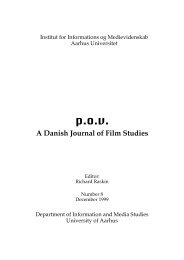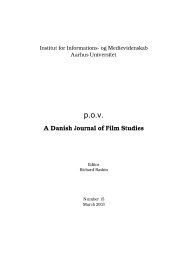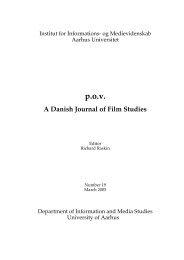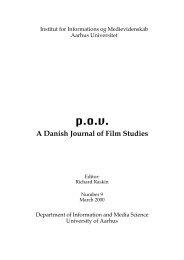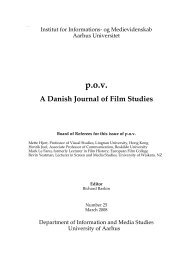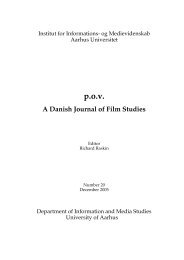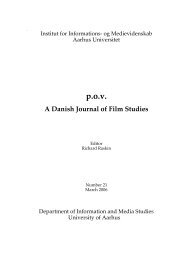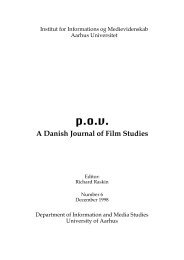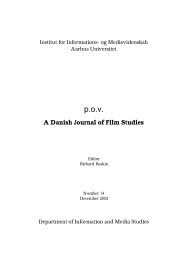The Face of Time - POV - Aarhus Universitet
The Face of Time - POV - Aarhus Universitet
The Face of Time - POV - Aarhus Universitet
You also want an ePaper? Increase the reach of your titles
YUMPU automatically turns print PDFs into web optimized ePapers that Google loves.
A Danish Journal <strong>of</strong> Film Studies 135<br />
ist” students because the “pre-scripting” <strong>of</strong> what they wanted to be<br />
their film felt for them like a natural part <strong>of</strong> the development<br />
process. But it was harder for the “docmentarists,” especially early<br />
in the development <strong>of</strong> their documentary projects.<br />
Nevertheless, I continued to encourage them all, before and after<br />
field research – indeed, throughout the whole development process<br />
and during the filming itself – to go on imagining concrete film<br />
scenes, but to always keep these provisional. <strong>The</strong>y were encouraged<br />
to pre-imagine how to film scenes in considerable detail, in spite <strong>of</strong><br />
knowing that they would have to reject most <strong>of</strong> these imaginings as<br />
the project developed. I wanted them to think <strong>of</strong> the imagined<br />
scenes as highly detailed sketches that were going to be rejected as<br />
the process developed. I tried to help them design parts <strong>of</strong> their field<br />
research to investigate whether these pre-imagined scenes were<br />
filmable “out there” in the real world. Almost invariably they were<br />
not, but I believed that having tried to imagine how to film it was an<br />
important preparation for actually having to film it. Later in the<br />
development process I would encourage them to imagine several<br />
ways <strong>of</strong> filming possible scenes – a series <strong>of</strong> “what if” scenarios –<br />
and ways <strong>of</strong> testing these possible scenarios and how to film them in<br />
the next stage <strong>of</strong> field research. In this way they could begin to<br />
appreciate what parts <strong>of</strong> the coming film were more predictable<br />
with regard to how they could be filmed, which parts were less<br />
predictable, and which parts were largely unpredictable.<br />
An important restriction in this “filmic imagination” training<br />
method was that they were not to spend too much time trying to<br />
imagine the whole film. I encouraged them to pre-imagine individual<br />
scenes and groups <strong>of</strong> scenes and to think <strong>of</strong> these as the possible<br />
building blocks for the film. But they were not encouraged to imag-



